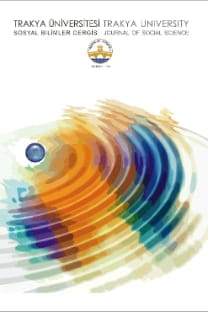TÜRKÇE ÖĞRETMENİ ADAYLARININ HAZIRLIKSIZ KONUŞMAYA YÖNELİK METAFORİK ALGILARI VE GÖRÜŞLERİ
Bu çalışmanın amacı Türkçe öğretmeni adaylarının hazırlıksız konuşmaya yönelik algılarını metaforlar aracılığıyla tespit etmektir. Olgubilim (fenomenoloji) yöntemiyle gerçekleştirilen çalışmada öğretmen adaylarının algılarını tespit etmek amacıyla araştırmacılar tarafından Hazırlıksız Konuşma Görüş Formu geliştirilmiş, formla ilgili alanın üç uzmanından görüşler alınmış ve forma son şekli verilmiştir. Çalışmanın örneklemi uygun örnekleme yöntemiyle oluşturulmuştur. Çalışmaya Hacettepe Üniversitesi, Gazi Üniversitesi ve Ondokuz Mayıs Üniversitesi’nde öğrenim görmüş ve görmekte olan 30 öğretmen adayı gönüllü olarak katılmıştır. Çalışmanın verileri anket yöntemiyle toplanmış, toplanan veriler içerik analizi yöntemiyle analiz edilmiştir. Çalışmanın sonucunda öğretmen adaylarının %50’sinin hazırlıksız konuşmayla ilgili kaygı yansıtan metaforlar ürettikleri tespit edilmiştir. Formda yer alan diğer maddeler katılımcıların hazırlıksız konuşmaya yönelik hissettikleri duyguların sebeplerinin anlaşılması amacıyla analiz edilmiştir. Katılımcıların kaygı duymalarının sebeplerinin konuşma planlayamama, düşünceleri organize edememe ve konuşma sürecini kontrol altında tutamama olduğu tespit edilmiştir. Öğretmen adaylarının hazırlıksız konuşmanın pedagojik öneminin farkında oldukları ve kendi öğrencilerine hazırlıksız konuşma öğretimi verme konusunda istekli oldukları anlaşılmıştır. Çalışmanın sonunda konuşma eğitimi sürecine yönelik birtakım önerilerde bulunulmuştur.
Anahtar Kelimeler:
hazırlıksız konuşma, metafor, hazırlıksız konuşma öğretimi, konuşma eğitimi, konuşma becerisi
METAPHORIC PERCEPTIONS AND OPINIONS OF TURKISH TEACHER CANDIDATES ABOUT IMPROMPTU SPEAKING
The aim of this study is to determine the perceptions of Turkish teacher candidates for impromptu speech through metaphors. In the study carried out with the phenomenology method, the Impromptu Speaking Opinion Form was developed by the researchers in order to determine the perceptions of the teacher candidates, the opinions of three experts in the field related to the form were taken and the form was finalized. The sample of the study was created with the appropriate sampling method. Thirty teacher candidates, who were educated and currently studying at Hacettepe University, Gazi University and Ondokuz Mayıs University, participated in the study voluntarily. The data of the study were collected by the questionnaire method, and the collected data were analyzed using the content analysis method. As a result of the study, it was determined that 50% of the teacher candidates produced metaphors reflecting anxiety about impromptu speech. Other items in the form were analyzed in order to understand the reasons for the feelings participants felt about impromptu speech. It was determined that the reasons for the anxiety of the participants were inability to plan a speech, to organize thoughts and to control the speaking process. It was understood that the pre-service teachers were aware of the pedagogical importance of impromptu speech and were willing to teach their students unprepared speaking. At the end of the study, some suggestions were made for the speaking education process.
Keywords:
impromptu speech, metaphor, teaching impromptu speaking, speaking training,
___
- Beebe, S. A., & Beebe, S. J. (2013). Public speaking handbook. Boston: Pearson Education.
- Brydon, S. R., & Scott, M. D. (2008). Between one and many: The art and science of public speaking. New York: McGraw-Hill Higher Education.
- Büyüköztürk, Ş., Kılıç Çakmak, E., Akgün, Ö. E., Karadeniz, Ş., & Demirel, F. (2017). Bilimsel araştırma yöntemleri. Ankara: Pegem Akademi Yayıncılık.
- Bytwerk, R. L. (1985). Impromptu speaking exercises. Communication Education, 34(2), 148-149.
- Coopman, S. J., & Lull, J. (2012). Public speaking: The evolving art. Boston: Wadsworth Cengage Learning.
- Creswell, J. W. (2013). Nitel araştırma yöntemleri. Ankara: Siyasal Kitabevi.
- Dean, K. W. (1987). Time well spent: Preparation for impromptu speaking. The Journal of the American Forensic Association, 23(4), 210-219.
- Doğan, Y. (2009). Konuşma becerisinin geliştirilmesine yönelik etkinlik önerileri. Türk Eğitim Bilimleri Dergisi, 7(1), 185-204.
- Dowling, F. (1957) Teaching impromptu speaking. The Speech Teacher, 6(3), 205-208.
- Fraleigh, D. M., & Tuman, J. S. (2017). Speak up: An illustrated guıde to public speaking. Boston: Bedford/St. Martin’s.
- Fredricks, S. M. (2005). Teaching impromptu speaking: a pictorial approach. Communication Teacher, 19(3), 75-79.
- Girardelli, D. (2017). Impromptu speech gamification for ESL/EFL students. Communication Teacher, 31(3), 156-161.
- Grice, G. L., & Skinner, J. F. (2010). Mastering public speaking. London: Pearson.
- Henderson, D. (1982). Impromptu Speaking as a Tool to Improve Nonnative Speakers’ Fluency in English. Jalt journal, 4(1), 75-87.
- Karakoç, B. (2019). Olgubilim araştırması. Şen, S., ve Yıldırım, İ. (Ed.), Eğitimde araştırma yöntemleri içinde (s.263-283). Ankara: Nobel Akademik Yayıncılık. Karaköse, V. (2019). 6. sınıf öğrencilerinin hazırlıksız konuşma becerilerinin geliştirilmesi üzerine bir çalışma (Yayımlanmamış yüksek lisans tezi). Gazi Üniversitesi, Ankara.
- Kurudayıoğlu, M. (2003). Konuşma eğimi ve konuşma becerisini geliştirmeye yönelik etkinlikler. Türklük Bilimi Araştırmaları, (13), 287-309.
- Kurudayıoğlu, M., & Kiraz, B. (2020). Hazırlıksız konuşma stratejileri. RumeliDE Dil ve Edebiyat Araştırmaları Dergisi, (20), 167-189.
- Nawi, R. A., Yasin, B., & Champion, C. R. (2015). Impromptu: great impromptu speaking is never just impromptu. Studıes In Englısh Language And Education, 2(2), 144-157.
- Rosenfeld, L. B. (1966). Teaching impromptu speaking. The Speech Teacher, 15(3), 232-234.
- Taşer, S. (2006). Konuşma eğitimi. İstanbul: Papirüs Yayıncılık.
- Turner, K., Osborn, R., Osborn, M., & Osborn, S. (2017). Public speaking: Finding your voice. Hoboken: Pearson Education.
- Vygotsky, L. S. (1998). Düşünce ve dil. İstanbul: Toplumsal Dönüşüm Yayınları.
- ISSN: 1305-7766
- Yayın Aralığı: Yılda 2 Sayı
- Başlangıç: 2000
- Yayıncı: Trakya Üniversitesi Sosyal Bilimler Enstitüsü
Sayıdaki Diğer Makaleler
İLKOKUL 4. SINIF ÖĞRENCİLERİNİN TRAFİK GÜVENLİĞİ KONUSUNA İLİŞKİN GÖRÜŞLERİNİN İNCELENMESİ
DİJİTAL KANAAT ÖNDERLERİNİN DİL KULLANIMI
DEMOKRAT PARTİ (1950-1960) DÖNEMİNDE ÖNEMLİ SALGIN HASTALIKLARINDAN SITMA ve VEREM İLE MÜCADELE
TÜRKÇE ÖĞRETMENİ ADAYLARININ HAZIRLIKSIZ KONUŞMAYA YÖNELİK METAFORİK ALGILARI VE GÖRÜŞLERİ
Mehmet KURUDAYIOĞLU, Büşra KİRAZ
YETİŞKİNLER İÇİN DİJİTAL OYUN BAĞIMLILIĞI ÖLÇEĞİ: TÜRKÇE UYARLAMA, GEÇERLİK VE GÜVENİRLİK ÇALIŞMASI
